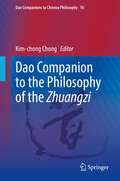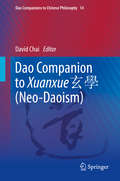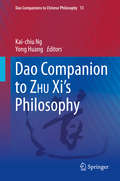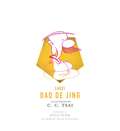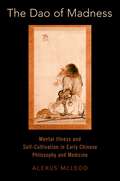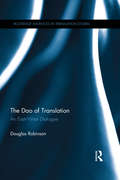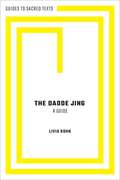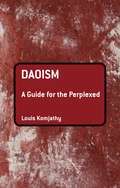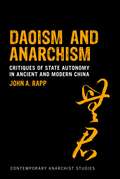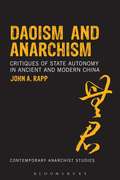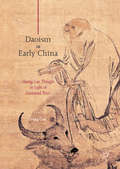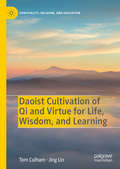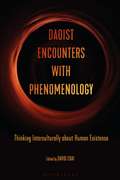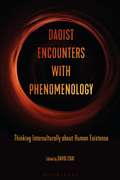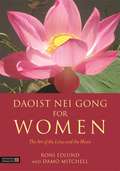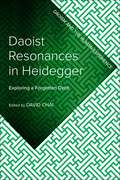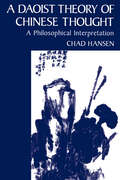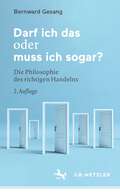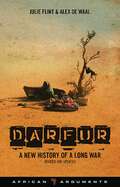- Table View
- List View
Dao Companion to the Philosophy of the Zhuangzi (Dao Companions to Chinese Philosophy #16)
by Kim-Chong ChongThis comprehensive collection brings out the rich and deep philosophical resources of the Zhuangzi. It covers textual, linguistic, hermeneutical, ethical, social/political and philosophical issues, with the latter including epistemological, metaphysical, phenomenological and cross-cultural (Chinese and Western) aspects. The volume starts out with the textual history of the Zhuangzi, and then examines how language is used in the text. It explores this unique characteristic of the Zhuangzi, in terms of its metaphorical forms, its use of humour in deriding and parodying the Confucians, and paradoxically making Confucius the spokesman for Zhuangzi’s own point of view. The volume discusses questions such as: Why does Zhuangzi use language in this way, and how does it work? Why does he not use straightforward propositional language? Why is language said to be inadequate to capture the “dao” and what is the nature of this dao? The volume puts Zhuangzi in the philosophical context of his times, and discusses how he relates to other philosophers such as Laozi, Xunzi, and the Logicians.
Dao Companion to Xuanxue 玄學 (Dao Companions to Chinese Philosophy #14)
by David ChaiThis comprehensive volume surveys an important but neglected period of Chinese intellectual history: Xuanxue (Neo-Daoism). It provides a holistic approach to the philosophical and religious traits of this movement via the concepts of non-being, being, and oneness. Thinkers and texts on the periphery of Xuanxue are also examined to show readers that Xuanxue did not arise in a vacuum but is the result of a long and continuous evolution of ideas from pre-Qin Daoism. The 25 chapters of this work survey the major philosophical figures and arguments of Xuanxue, a movement from the Wei-Jin dynastic period (220-420 CE) of early-medieval China. It also examines texts and figures from the late-Han dynasty whose influence on Xuanxue has yet to be made explicitly clear. In order to fully capture the multifaceted nature of this movement, the contributors brilliantly highlight its more socially-oriented characteristics. Overall, this volume presents an unrivaled picture of this exciting period. It details a portrait of intellectual and cultural vitality that rivals, if not surpasses, what was achieved during the Warring States period. Readers of the Yijing, Daodejing, and Zhuangzi will feel right at home with the themes and arguments presented herein, while students and those coming to Xuanxue for the first time will acquire a wealth of knowledge.
Dao Companion to ZHU Xi’s Philosophy (Dao Companions to Chinese Philosophy #13)
by Yong Huang Kai-Chiu NgZhu Xi (1130-1200) has been commonly and justifiably recognized as the most influential philosopher of Neo-Confucianism, a revival of classical Confucianism in face of the challenges coming from Daoism and, more importantly, Buddhism. His place in the Confucian tradition is often and also very plausibly compared to that of Thomas Aquinas, slightly later, in the Christian tradition. This book presents the most comprehensive and updated study of this great philosopher. It situates Zhu Xi’s philosophy in the historical context of not only Confucian philosophy but also Chinese philosophy as a whole. Topics covered within Zhu Xi’s thought are metaphysics, epistemology, ethics, political philosophy, hermeneutics, philosophy of religion, moral psychology, and moral education. This text shows both how Zhu Xi responded to earlier thinkers and how his thoughts resonate in contemporary philosophy, particularly in the analytic tradition. This companion will appeal to students, researchers and educators in the field.
Dao De Jing (The Illustrated Library of Chinese Classics #27)
by Laozi C. C. TsaiFrom bestselling cartoonist C. C. Tsai, a delightfully illustrated version of the classic work of Daoist philosophyC. C. Tsai is one of Asia's most popular cartoonists, and his editions of the Chinese classics have sold more than 40 million copies in over twenty languages. Here, he works his magic again with a delightful graphic adaptation of the complete text of Laozi's Dao De Jing, the beloved source of Daoist philosophy. Masterfully transforming Laozi's challenging work into entertaining and enlightening episodes, Tsai offers a uniquely fresh, relevant, and accessible version of one of the world's most influential books.After opening with Laozi's biography from the Shi Ji, Tsai turns the stage over to Laozi, who patiently explains his ideas to his earnest students (and us). Laozi describes the spontaneity of natural processes, the paradoxical effects of ethical precepts, the limits of language, the values of simplicity, and, above all else, how to go with the flow. In brief episodes that tantalize and inspire, he takes us into the subtle complexities of human existence. Ultimately, Laozi, a master visionary, guides us to the mountaintop to reveal an expansive view of life.A marvelous edition of a timeless classic, this book also presents Laozi's original Chinese text in sidebars on each page, enriching the book for readers and students of Chinese without distracting from the English-language cartoons. The text is skillfully translated by Brian Bruya, who also provides an illuminating introduction.
The Dao of Madness: Mental Illness and Self-Cultivation in Early Chinese Philosophy and Medicine
by Alexus McLeodMental illness complicates views of agency and moral responsibility in ethics. Particularly for traditions and theories focused on self-cultivation, such as Aristotelian virtue ethics and many systems of ethics in early Chinese philosophy, mental illness offers powerful challenges. Can the mentally ill person cultivate herself and achieve a level of virtue, character, or thriving similar to the mentally healthy? Does mental illness result from failures in self-cultivation, failure in social institutions or rulership, or other features of human activity? Can a life complicated by struggles with mental illness be a good one? The Dao of Madness investigates the role of mental illness, specifically "madness" (kuang), in discussions of self-cultivation and ideal personhood in early Chinese philosophical and medical thought, and the ways in which early Chinese thinkers probed difficult questions surrounding mental health. Alexus McLeod explores three central accounts: the early "traditional" views of those, including Confucians, taking madness to be the result of character flaw; the challenge from Zhuangists celebrating madness as a freedom from standard norms connected to knowledge; and the "medicalization" of madness within the naturalistic shift of Han Dynasty thought. Understanding views on madness in the ancient world helps reveal key features of Chinese thinkers' conceptions of personhood and agency, as well as their accounts of ideal activity. Further, it exposes the motivations behind the origins of the medical tradition, and of the key links between philosophy and medicine in early Chinese thought. The early Chinese medical tradition has crucial and understudied connections to early philosophy, connections which this volume works to uncover.
The Dao of Madness: Mental Illness and Self-Cultivation in Early Chinese Philosophy and Medicine
by Alexus McLeodMental illness complicates views of agency and moral responsibility in ethics. Particularly for traditions and theories focused on self-cultivation, such as Aristotelian virtue ethics and many systems of ethics in early Chinese philosophy, mental illness offers powerful challenges. Can the mentally ill person cultivate herself and achieve a level of virtue, character, or thriving similar to the mentally healthy? Does mental illness result from failures in self-cultivation, failure in social institutions or rulership, or other features of human activity? Can a life complicated by struggles with mental illness be a good one? The Dao of Madness investigates the role of mental illness, specifically "madness" (kuang), in discussions of self-cultivation and ideal personhood in early Chinese philosophical and medical thought, and the ways in which early Chinese thinkers probed difficult questions surrounding mental health. Alexus McLeod explores three central accounts: the early "traditional" views of those, including Confucians, taking madness to be the result of character flaw; the challenge from Zhuangists celebrating madness as a freedom from standard norms connected to knowledge; and the "medicalization" of madness within the naturalistic shift of Han Dynasty thought. Understanding views on madness in the ancient world helps reveal key features of Chinese thinkers' conceptions of personhood and agency, as well as their accounts of ideal activity. Further, it exposes the motivations behind the origins of the medical tradition, and of the key links between philosophy and medicine in early Chinese thought. The early Chinese medical tradition has crucial and understudied connections to early philosophy, connections which this volume works to uncover.
The Dao of Translation: An East-West Dialogue (Routledge Advances in Translation and Interpreting Studies)
by Douglas RobinsonThe Dao of Translation sets up an East-West dialogue on the nature of language and translation, and specifically on the "unknown forces" that shape the act of translation. To that end it mobilizes two radically different readings of the Daodejing (formerly romanized as the Tao Te Ching): the traditional "mystical" reading according to which the Dao is a mysterious force that cannot be known, and a more recent reading put forward by Sinologists Roger T. Ames and David L. Hall, to the effect that the Dao is simply the way things happen. Key to Ames and Hall’s reading is that what makes the Dao seem both powerful and mysterious is that it channels habit into action—or what the author calls social ecologies, or icoses. The author puts Daoism (and ancient Confucianism) into dialogue with nineteenth-century Western theorists of the sign, Charles Sanders Peirce and Ferdinand de Saussure (and their followers), in order to develop an "icotic" understanding of the tensions between habit and surprise in the activity of translating. The Dao of Translation will interest linguists and translation scholars. This book will also engage researchers of ancient Chinese philosophy and provide Western scholars with a thought-provoking cross-examination of Eastern and Western perspectives.
The Dao of Translation: An East-West Dialogue (Routledge Advances in Translation and Interpreting Studies)
by Douglas RobinsonThe Dao of Translation sets up an East-West dialogue on the nature of language and translation, and specifically on the "unknown forces" that shape the act of translation. To that end it mobilizes two radically different readings of the Daodejing (formerly romanized as the Tao Te Ching): the traditional "mystical" reading according to which the Dao is a mysterious force that cannot be known, and a more recent reading put forward by Sinologists Roger T. Ames and David L. Hall, to the effect that the Dao is simply the way things happen. Key to Ames and Hall’s reading is that what makes the Dao seem both powerful and mysterious is that it channels habit into action—or what the author calls social ecologies, or icoses. The author puts Daoism (and ancient Confucianism) into dialogue with nineteenth-century Western theorists of the sign, Charles Sanders Peirce and Ferdinand de Saussure (and their followers), in order to develop an "icotic" understanding of the tensions between habit and surprise in the activity of translating. The Dao of Translation will interest linguists and translation scholars. This book will also engage researchers of ancient Chinese philosophy and provide Western scholars with a thought-provoking cross-examination of Eastern and Western perspectives.
The Daode Jing: A Guide (Guides to Sacred Texts)
by Livia KohnThe Daode jing ("Book of the Dao and Its Virtue") is an essential work in both traditional Chinese culture and world philosophy. The oldest text of philosophical Daoism, and widely venerated among religious Daoist practitioners, it was composed around the middle of the 4th century BCE. Ascribed to a thinker named Laozi, a contemporary of Confucius, the work is based on a set of aphorisms designed to help local lords improve their techniques of government. The most translated book after the Bible, the Daode jing appears in numerous variants and remains highly relevant in the modern world. This guide provides an overview of the text, presenting its historical unfolding, its major concepts, and its contemporary use. It also gives some indication of its essence by citing relevant passages and linking them to the religious practices of traditional Daoism.
DAODE JING: A Guide (Guides to Sacred Texts)
by Livia KohnThe Daode jing ("Book of the Dao and Its Virtue") is an essential work in both traditional Chinese culture and world philosophy. The oldest text of philosophical Daoism, and widely venerated among religious Daoist practitioners, it was composed around the middle of the 4th century BCE. Ascribed to a thinker named Laozi, a contemporary of Confucius, the work is based on a set of aphorisms designed to help local lords improve their techniques of government. The most translated book after the Bible, the Daode jing appears in numerous variants and remains highly relevant in the modern world. This guide provides an overview of the text, presenting its historical unfolding, its major concepts, and its contemporary use. It also gives some indication of its essence by citing relevant passages and linking them to the religious practices of traditional Daoism.
Daoism: A Guide for the Perplexed (Guides for the Perplexed)
by Louis KomjathyDaoism is a global religious and cultural phenomenon characterized by multiculturalism and ethnic diversity. Daoism: A Guide for the Perplexed offers a clear and thorough survey of this ancient and modern religious tradition. The book includes an overview of Daoist history, including key individuals and movements, translations of primary Daoist texts, and discussions of key dimensions of Daoist religiosity, covering primary concerns and defining characteristics of the religion.Specifically designed to meet the needs of students and general readers seeking a thorough understanding of the religion, this book is the ideal guide to studying and understanding Daoism as a lived and living religious community.
Daoism: Mysticism And Self-transformation In Early Quanzhen Daoism (Guides for the Perplexed #311)
by Louis KomjathyDaoism is a global religious and cultural phenomenon characterized by multiculturalism and ethnic diversity. Daoism: A Guide for the Perplexed offers a clear and thorough survey of this ancient and modern religious tradition. The book includes an overview of Daoist history, including key individuals and movements, translations of primary Daoist texts, and discussions of key dimensions of Daoist religiosity, covering primary concerns and defining characteristics of the religion.Specifically designed to meet the needs of students and general readers seeking a thorough understanding of the religion, this book is the ideal guide to studying and understanding Daoism as a lived and living religious community.
Daoism and Anarchism: Critiques of State Autonomy in Ancient and Modern China (Contemporary Anarchist Studies)
by John A. RappThis volume in the Contemporary Anarchist Studies series focuses on anti-statist critiques in ancient and modern China and demonstrates that China does not have an unchallenged authoritarian political culture.Treating anarchism as a critique of centralized state power, the work first examines radical Daoist thought from the 4th century BCE to the 9th century CE and compares Daoist philosophers and poets to Western anarchist and utopian thinkers. This is followed by a survey of anarchist themes in dissident thought in the People's Republic of China from 1949 to the present. A concluding chapter discusses how Daoist anarchism can be applied to any anarchist-inspired radical critique today. This work not only challenges the usual ideas of the scope and nature of dissent in China, it also provides a unique comparison of ancient Chinese Daoist anarchism to Western anarchist. Featuring previously untranslated texts, such as the 9th century Buddhist anarchist tract, the Wunengzi, and essays from the PRC press, it will be an essential resource to anyone studying anarchism, Chinese political thought, political dissent, and political history.
Daoism and Anarchism: Critiques of State Autonomy in Ancient and Modern China (Contemporary Anarchist Studies)
by John A. RappThis volume in the Contemporary Anarchist Studies series focuses on anti-statist critiques in ancient and modern China and demonstrates that China does not have an unchallenged authoritarian political culture.Treating anarchism as a critique of centralized state power, the work first examines radical Daoist thought from the 4th century BCE to the 9th century CE and compares Daoist philosophers and poets to Western anarchist and utopian thinkers. This is followed by a survey of anarchist themes in dissident thought in the People's Republic of China from 1949 to the present. A concluding chapter discusses how Daoist anarchism can be applied to any anarchist-inspired radical critique today. This work not only challenges the usual ideas of the scope and nature of dissent in China, it also provides a unique comparison of ancient Chinese Daoist anarchism to Western anarchist. Featuring previously untranslated texts, such as the 9th century Buddhist anarchist tract, the Wunengzi, and essays from the PRC press, it will be an essential resource to anyone studying anarchism, Chinese political thought, political dissent, and political history.
Daoism in Early China: Huang-Lao Thought in Light of Excavated Texts
by Feng CaoThis text considers the prevalence of Lao-Zhuang Daoism and Huang-Lao Daoism in late pre-imperial and early imperial Chinese traditional thought. The author uses unique excavated documents and literature to explore the Huang-Lao tradition of Daoist philosophy, which exerted a great influence on China ancient philosophy and political theories, from the Pre-Qin period to the Wei-Jin periods. It explains the original and significance of Huang-Lao Daoism, its history and fundamental characteristics, notably discussing the two sides of Huang-Lao, namely the role and function of Lao Zi and the Yellow Emperor, and discusses why the two can constitute a complementary relationship. It also provides a key study of the Mawangdui silk texts, bamboo slips of the Heng Xian, Fan Wu Liu Xing, considering both the theory of human Xing and of Qi.
Daoist Cultivation of Qi and Virtue for Life, Wisdom, and Learning (Spirituality, Religion, and Education)
by Tom Culham Jing LinThis book explores Daoist philosophies of qi and virtue through inquiry into their potential as technologies for cultivating good among individuals and society within educational settings, as well as in the modern world. The first part of the book, authored by Jing Lin, examines Daoist cosmology, axiology, and epistemology. She illuminates qi cultivation’s reliance on the accumulation of virtues, leading to transformation of the body and even—extraordinarily—the abilities of Daoist masters to transcend physical limitations to achieve health, longevity, and immortality. The second part of the book, authored by Tom Culham, establishes an understanding of qi and virtue as a technology within the Daoist paradigm, outlining the benefits of its cultivation while illuminating how contemporary Western philosophy and science support this paradigm. Both authors explore new forms of education to incorporate Daoist wisdom in schooling.
Daoist Encounters with Phenomenology: Thinking Interculturally about Human Existence
by David ChaiThis collection is intercultural philosophy at its best. It contextualizes the global significance of the leading figures of Western phenomenology, including Husserl, Hegel, Nietzsche, Heidegger, Buber and Levinas, enters them into intercultural dialogue with the Daoism of Laozi and Zhuangzi and in doing so, breaks new ground. By presenting the first sustained analysis of the Daoist worldview by way of phenomenological experience, this book not only furthers our understanding of Daoism and phenomenology, but delves deeper into the roots of human thinking, aesthetic expression, and its impact on the modern social world. The international team of philosophers approach the phenomenological tradition in the broadest sense possible, looking beyond the phenomenological language of Husserl.With chapters on art, ethics, death and the metaphor of dream and hermeneutics, this collection encourages scholars and students in both Asian and Western traditions to rethink their philosophical bearings and engage in meaningful intercultural dialogue.
Daoist Encounters with Phenomenology: Thinking Interculturally about Human Existence
by David ChaiThis collection is intercultural philosophy at its best. It contextualizes the global significance of the leading figures of Western phenomenology, including Husserl, Hegel, Nietzsche, Heidegger, Buber and Levinas, enters them into intercultural dialogue with the Daoism of Laozi and Zhuangzi and in doing so, breaks new ground. By presenting the first sustained analysis of the Daoist worldview by way of phenomenological experience, this book not only furthers our understanding of Daoism and phenomenology, but delves deeper into the roots of human thinking, aesthetic expression, and its impact on the modern social world. The international team of philosophers approach the phenomenological tradition in the broadest sense possible, looking beyond the phenomenological language of Husserl.With chapters on art, ethics, death and the metaphor of dream and hermeneutics, this collection encourages scholars and students in both Asian and Western traditions to rethink their philosophical bearings and engage in meaningful intercultural dialogue.
Daoist Nei Gong for Women: The Art of the Lotus and the Moon (PDF)
by Damo Mitchell Roni Edlund Sophie JohnsonAlthough the energetic anatomy of men and women is different, the ancient teachings of Nu Dan, a separate branch of internal alchemy for women, have been lost in the literature over the centuries and only survive through practice in the lineages. This book takes a detailed look at female energetic anatomy, exploring how it is different from its male counterpart, and explains and describes the specific practices which support the unique strengths and challenges that the female energy system presents. Previously wrapped in secrecy, the teachings in this book include qigong exercises that activate the energy of the uterus and an explanation of how menstruation and a connection to the cycles of the moon can be converted into a tool for Nei Gong development.
Daoist Nei Gong for Women: The Art of the Lotus and the Moon
by Damo Mitchell Sophie Johnson Roni EdlundAlthough the energetic anatomy of men and women is different, the ancient teachings of Nu Dan, a separate branch of internal alchemy for women, have been lost in the literature over the centuries and only survive through practice in the lineages. This book takes a detailed look at female energetic anatomy, exploring how it is different from its male counterpart, and explains and describes the specific practices which support the unique strengths and challenges that the female energy system presents. Previously wrapped in secrecy, the teachings in this book include qigong exercises that activate the energy of the uterus and an explanation of how menstruation and a connection to the cycles of the moon can be converted into a tool for Nei Gong development.
Daoist Resonances in Heidegger: Exploring a Forgotten Debt (Daoism and the Human Experience)
by David ChaiEast Asian imagery resonates throughout Martin Heidegger's writings. In this exploration of the connections between Daoism and his thought, an international team of scholars consider why the Daodejing and Zhuangzi were texts he returned to repeatedly and the extent Heidegger adhered to Daoism's core doctrines. They discuss how Daoist thought provided him with a new perspective, equipping him with images, concepts, and meanings that enabled him to continue his questioning of the nature of being. Exploring the environment, language, death, temporality, aesthetics, and race from the groundlessness of non-being, oneness, and the Way, they illustrate how these themes reverberate with ontological, spiritual, and epistemological potential. A lesson in the art of Daoist and cross-cultural ways of thinking, this collection marks the first sustained analysis of the influence of classical Daoism on a major 20th-century German philosopher.
Daoist Resonances in Heidegger: Exploring a Forgotten Debt (Daoism and the Human Experience)
East Asian imagery resonates throughout Martin Heidegger's writings. In this exploration of the connections between Daoism and his thought, an international team of scholars consider why the Daodejing and Zhuangzi were texts he returned to repeatedly and the extent Heidegger adhered to Daoism's core doctrines. They discuss how Daoist thought provided him with a new perspective, equipping him with images, concepts, and meanings that enabled him to continue his questioning of the nature of being. Exploring the environment, language, death, temporality, aesthetics, and race from the groundlessness of non-being, oneness, and the Way, they illustrate how these themes reverberate with ontological, spiritual, and epistemological potential. A lesson in the art of Daoist and cross-cultural ways of thinking, this collection marks the first sustained analysis of the influence of classical Daoism on a major 20th-century German philosopher.
A Daoist Theory of Chinese Thought: A Philosophical Interpretation
by Chad HansenThis ambitious book presents a new interpretation of Chinese thought guided both by a philosopher's sense of mystery and by a sound philosophical theory of meaning. That dual goal, Hansen argues, requires a unified translation theory. It must provide a single coherent account of the issues that motivated both the recently untangled Chinese linguistic analysis and the familiar moral-political disputes. Hansen's unified approach uncovers a philosophical sophistication in Daoism that traditional accounts have overlooked.
Darf ich das oder muss ich sogar?: Die Philosophie des richtigen Handelns
by Bernward GesangOb es um Weltarmut oder um Genfood geht, ob um die Erderwärmung oder die Menschenrechte, ob um Flüchtlingspolitik oder die Verteilung medizinischer Güter, - immer stoßen wir auf drängende Fragen der Moral und ihrer Entscheidung. Dieses Buch bietet keine Patentrezepte für richtiges Handeln, führt aber in alle wichtigen Begriffe und Grundlagen ethischen Denkens und in die Werkzeuge zur Entscheidungsfindung ein. Auf der Basis einer praktisch orientierten utilitaristischen Interessensethik findet der Autor originelle Antworten auf viele wichtige Fragen der Gegenwart.
Darfur: A Short History of a Long War (African Arguments)
by Julie Flint Alex de WaalWritten by two authors with unparalleled first-hand experience of Darfur, this is the definitive guide. Newly updated and hugely expanded, this edition details Darfur's history in Sudan. It traces the origins, organization and ideology of the infamous Janjawiid and rebel groups, including the Sudan Liberation Army and the Justice and Equality Movement. It also analyses the brutal response of the Sudanese government. The authors investigate the responses by the African Union and the international community, including the halting peace talks and the attempts at peacekeeping. Flint and de Waal provide an authoritative and compelling account of contemporary Africa's most controversial conflict.
